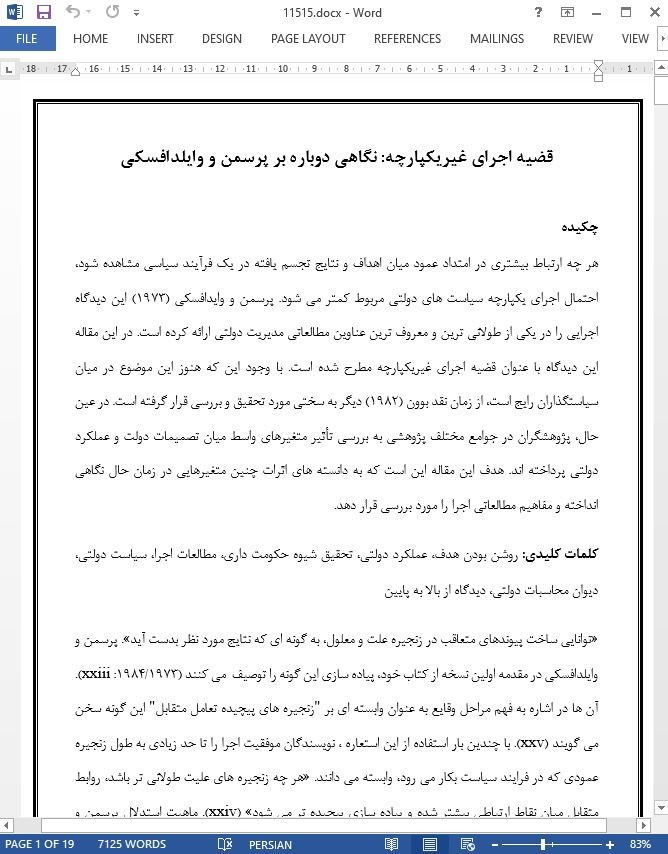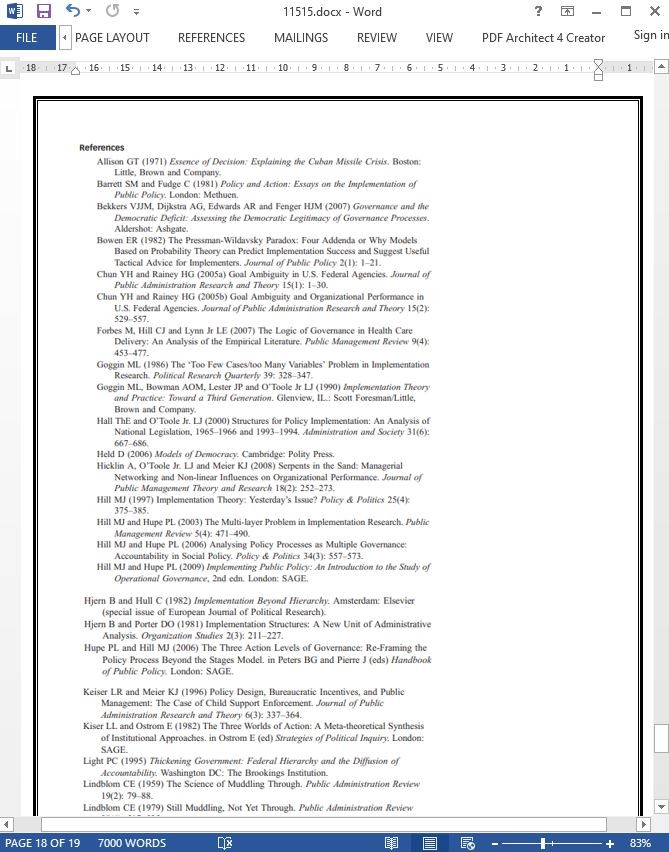
قضیه اجرای غیریکپارچه: نگاهی دوباره بر پرسمن و وایلدافسکی
چکیده
هر چه ارتباط بیشتری در امتداد عمود میان اهداف و نتایج تجسم یافته در یک فرآیند سیاسی مشاهده شود، احتمال اجرای یکپارچه سیاست های دولتی مربوط کمتر می شود. پرسمن و وایدافسکی (1973) این دیدگاه اجرایی را در یکی از طولانی ترین و معروف ترین عناوین مطالعاتی مدیریت دولتی ارائه کرده است. در این مقاله این دیدگاه با عنوان قضیه اجرای غیریکپارچه مطرح شده است. با وجود این که هنوز این موضوع در میان سیاستگذاران رایج است، از زمان نقد بوون (1982) دیگر به سختی مورد تحقیق و بررسی قرار گرفته است. در عین حال، پژوهشگران در جوامع مختلف پژوهشی به بررسی تأثیر متغیرهای واسط میان تصمیمات دولت و عملکرد دولتی پرداخته اند. هدف این مقاله این است که به دانسته های اثرات چنین متغیرهایی در زمان حال نگاهی انداخته و مفاهیم مطالعاتی اجرا را مورد بررسی قرار دهد.
«توانایی ساخت پیوندهای متعاقب در زنجیره علت و معلول، به گونه ای که نتایج مورد نظر بدست آید». پرسمن و وایلدافسکی در مقدمه اولین نسخه از کتاب خود، پیاده سازی این گونه را توصیف می کنند (1973/1984: xxiii). آن ها در اشاره به فهم مراحل وقایع به عنوان وابسته ای بر "زنجیره های پیچیده تعامل متقابل" این گونه سخن می گویند (xxv). با چندین بار استفاده از این استعاره ، نویسندگان موفقیت اجرا را تا حد زیادی به طول زنجیره عمودی که در فرایند سیاست بکار می رود، وابسته می دانند. «هر چه زنجیره های علیت طولانی تر باشد، روابط متقابل میان نقاط ارتباطی بیشتر شده و پیاده سازی پیچیده تر می شود» (xxiv). ماهیت استدلال پرسمن و ویلدوفسکی این است که هرچه در "زنجیره" عمودی یک فرایند سیاسی "مجوز" بیشتر وجود داشته باشد، احتمال اجرای یکپارچه با اهداف سیاسی سیاست مربوطه کاهش می یابد. فرض این است که اگر عمل به بازه ای از ارتباطات موجود در یک خط عمودی اجرا بستگی داشته باشد، میزان همکاری میان سازمان هایی که برای ایجاد این ارتباطات نیاز است باید نزدیک به 100 درصد باشد که وضعیتی رخ ندهد که در آن تعداد کمبودهای کوچک، به طور جمعی، کمبود بزرگی را ایجاد می کنند.
نتیجه گیری
چگونه دانسته ها در مورد اثرات متغیرهای واسطه میان اهداف دولت و عملکرد دولت به توضیح تغییرات در نتایج اجرا کمک کند؟ در این جا به شیوه نتیجه گیری با رسم خطوط پراهمیت در بخش های پیشین به این پرسش اصولی اشاره می شود. نظر به تحقیقات آینده، تعدادی از مفروضات روش شناسی و تئوری شناسایی شده اند.
Abstract
The more links can be observed in the vertical line between intentions and results as embodied by a policy process, the smaller the chance will be of a congruent implementation of the public policy concerned. Pressman and Wildavsky (1973) expressed this view on implementation in one of the longest and most famous subtitles in the study of public administration. In this article this view is addressed as the thesis of incongruent implementation. Although still common with policy makers, since Bowen’s (1982) critique it hardly has been investigated further. At the same time, however, scholars across different research communities have started to explore the effects of intermediary variables between government intentions and governmental performance. The objective in this article is to look at what is known about the impact of such variables currently and to explore the implications for the study of implementation.
‘(T)he ability to forge subsequent links in the causal chain so as to obtain the desired results.’ That is how Pressman and Wildavsky describe implementation in the preface to the first edition of their book (1973/1984: xxiii). They speak about understanding sequences of events as depending on ‘complex chains of reciprocal interaction’ (xxv). Using the metaphor several times, the authors see the success of implementation as highly dependent on the length of the vertical ‘chain’ implied by the policy process involved. ‘The longer the chains of causality, the more numerous the reciprocal relationships among the links and the more complex implementation becomes’ (xxiv). The essence of Pressman and Wildavsky’s argument is that the more ‘clearances’ there are in the vertical ‘chain’ of a policy process, the smaller the chance will be of an implementation congruent with the policy intentions of the policy concerned. The assumption is that if action depends upon a range of links in a vertical line of implementation, the degree of co-operation between agencies required to make those links has to be close to 100 per cent if a situation is not to occur in which a number of small deficits create a large shortfall in a cumulative way.
Conclusion
How can knowledge about effects of intermediary variables between government intentions and governmental performance contribute to the explanation of variation in implementation results? That underlying research question is addressed here in a concluding way by drawing some lines consequential to the argument of the previous sections. With an eye on future research a number of methodological and theoretical assumptions are identified.
چکیده
تاثیر سلسله مراتب در اجرا
برخی شواهد تجربی
انتظارات معلوم و رابطه لایه ها/کمبودها
فرضیه 1: محدودیت تعداد رابط های عمودی باعث افزایش اجرای یکپارچه می شود
فرضیه 2: متمرکز سازی، یکپارچگی اجرا را افزایش می دهد
فرضیه 3: وضوح هدف، اجرای یکپارچه را افزایش می دهد
محدودیت های تاثیر سلسله مراتب بر اجرا
انواع تجربی: سیستم های حکومتی
محدودیت 1: نتایج اجرا از مکانیسم های تعامل اجتماعی
محدودیت 2: اجرا در چند موقعیت محلی انجام می پذیرد
محدودیت 3: اجرا به فعالیت های انسانی مربوط می شود
بازبینی قضیه اجرای غیر یکپارچه
نتیجه گیری
Abstract
The Impact of Hierarchy on Implementation: Some Empirical Evidence
Dashed Expectations and the Layers/Deficits Nexus
Supposition 1: Limitation of the Number of Vertical Links Enhances Congruent Implementation
Supposition 2: Centralisation Enhances Congruent Implementation
Supposition 3: Goal Clarity Enhances Congruent Implementation
Limitations on the Impact of Hierarchy on Implementation
Empirical Variety: Systems of Governance
Limitation 1: Implementation Results from Mechanisms of Social Interaction
Limitation 2: Implementation is Multi-local
Limitation 3: Implementation Refers to Human Agency
Reviewing the Thesis of Incongruent Implementation
Conclusion
- اصل مقاله انگلیسی با فرمت ورد (word) با قابلیت ویرایش
- ترجمه فارسی مقاله با فرمت ورد (word) با قابلیت ویرایش، بدون آرم سایت ای ترجمه
- ترجمه فارسی مقاله با فرمت pdf، بدون آرم سایت ای ترجمه


